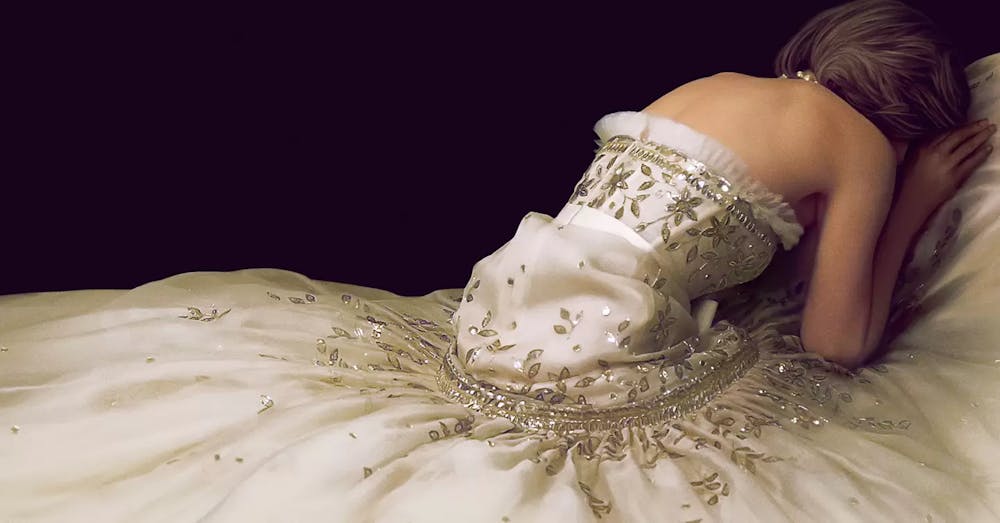Princess Diana, née Spencer, is one of the most beloved and adored figures of the last century. Commonly referred to as the “People’s Princess,” Diana lived a tragic yet iconic life where every decision of hers was scrutinized.
Numerous documentaries and shows have attempted to recount Diana’s highly public life. Spencer is, thankfully, not one of them.
Instead, Spencer focuses on one pivotal weekend in Diana’s life, in which no one truly knows what happened: her last Christmas married to Prince Charles. Spencer positions the 1991 Christmas as the weekend Diana decides that her marriage is over. With no paparazzi to account for what unfolded at the Royal Family’s Sandringham estate, this is a strictly fictional interpretation of Diana’s Christmas. It's fascinating to watch a movie that is centered on such a public figure yet still highlights a few private days in her life.
While Spencer is a Princess Diana movie, it is more so a psychological film. This movie is extremely haunting in how Diana struggles with her role as a member of the tightly guarded and traditional Royal Family. Diana trespasses on people’s property, gets lost at night, argues with police authority, and deals with multiple bulimic episodes. Here, Diana is living no fairytale.
Spencer shines in its ability to subvert the audience’s expectations of what a historical drama can be. The official poster of Spencer, with star Kristen Stewart elegantly lying on the floor wearing a gold and silver gown from Chanel that took 1,054 hours to construct, is one example of the movie’s subversion. Diana's devastating, regal pose conjures the assumption that she's at some royal function. In reality, the black background crops out a toilet where Diana is throwing up her dinner. Meanwhile, the Royal Family continues their Christmas celebrations and pretends to act oblivious to Diana’s eating disorder—not very elegant in the slightest.
While Spencer does include exceptional sets, costumes, and performances by secondary characters like Diana’s royal dresser, played by Sally Hawkins, and Sandringham estate runner Major Alistair Gregory, played by Timothy Spall, this movie hinges completely on Stewart’s performance of Princess Diana. Without a doubt, Stewart gives the best performance of her life and of the year. Her spot–on Princess Diana accent and mannerisms make for a heartbreaking and authentic performance.
What makes Stewart’s performance different from the rest of her Diana contemporaries is that she is not acting as Diana the icon. Stewart fleshes Diana out into a worried mother who is struggling to keep her life from falling apart, an aspect of the person much more relatable than the princess whose wedding was watched by billions of people.
In many ways, this has been the role that Stewart has been working for since she left the Twilight series. After going through an indie phase, not unlike her co–star Robert Pattinson, Stewart slowly earned critical praise and fans who were not just teenage girls. Speaking to the Hollywood Reporter, Stewart acknowledged that Diana and herself have similarly both lived highly scrutinized lives: “I have a lot of cameras in my life; I have to talk to people about things that I cherish.” Yet, Stewart also recognizes that she is much more free than Diana, who had to live a dishonest life when facing the public. “I can’t even imagine what it would have been like to be forced to perpetuate a lie,” Stewart said when discussing Diana’s life.
Despite being a movie centered around Christmas, which is often associated with themes of family and community, the rest of the Royal Family besides Diana are rarely shown. Diana has one intense scene with Prince Charles, a few with William and Harry, one with Queen Elizabeth, and that’s it for the Royal Family. Rather, the members lurk in the shadows, which helps create Diana’s feeling of entrapment. The same holds true to the unnamed Camilla Parker Bowles, who is in the background of just one scene, but her influence over Prince Charles remains a deep concern to Diana throughout the film.
Pablo Larraín, the director of Spencer, is no stranger to semi–fictional biopics. In 2016, Larraín directed Jackie, which recounted the days after John F. Kennedy was assassinated. But while Jackie remains somewhat historically accurate, Spencer runs freely with few elements of reality. This allows Larraín to take Diana through imaginative and totally impractical scenarios to intensify her feelings of isolation and torment in her marriage.
Without giving any spoilers, Diana takes several life–threatening risks, which are not at all shown in the trailers. Diana also becomes captured by a fellow royal wife who was betrayed by her husband: Anne Boleyn. The ghost of Anne Boleyn follows Diana throughout the film, as Diana feels tethered to Anne’s life and grows worried that she will face a tragic fate similar to Anne's. With a hint of accurate foreshadowing, Spencer argues that Diana’s death due to a car crash is the modern equivalent to Anne Boleyn’s beheading in relation to the royal timeline.
All of the events of Spencer are backed by a roaring score composed by Jonny Greenwood. Blending jazz and classical music, he perfectly demonstrates Diana’s modern interpretation of tradition and the burden she feels as a member of the British Royal Family.
Hollywood is in the middle of its Diana–sance, highlighting her innocent and exposed life. Just this very year, there are three Princess Diana projects being filmed or released: The Crown Season Five is filming with Elizabeth Debicki, Diana: The Musical has just hit Broadway, and of course, Spencer was released in theaters this November.
Hopefully the Diana craze will fizzle out, as most of these projects merely try to capture the glamor and tragedy of Diana’s life. We could all honor the legacy of the People's Princess with much more respect, letting the world remember the mother with a family over the figure that lived a wildly public life.







